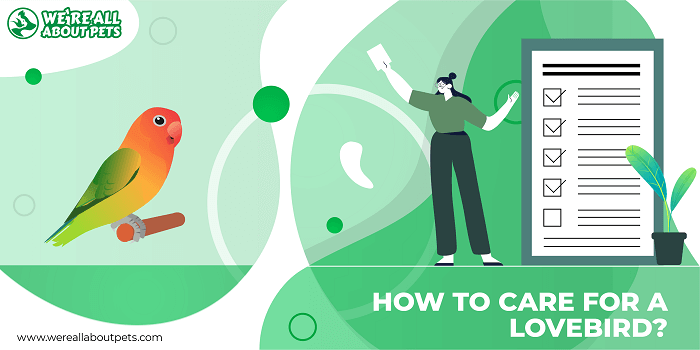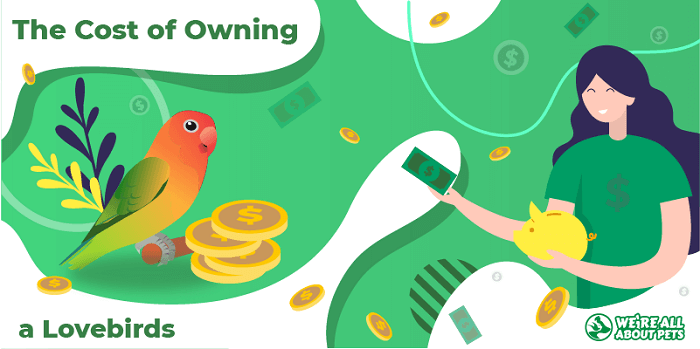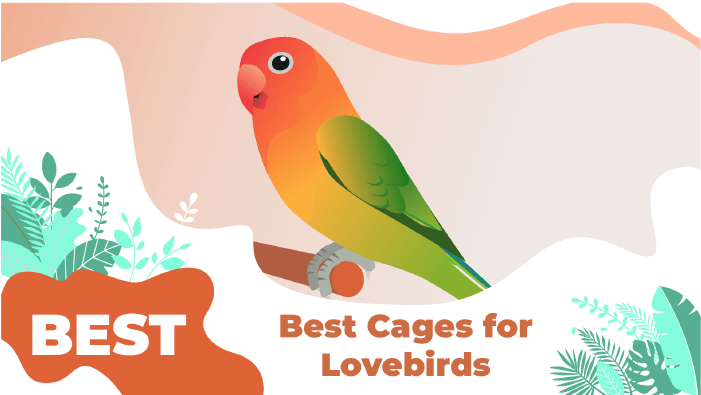How To Care For A Lovebird?
This page contains affiliate links. We may earn money or products from the companies mentioned in this post through our independently chosen links, which earn us a commission. Learn More
General Stats:
- Pet Type: Bird
- Size: Up to 7 inches
- Diet: Omnivore
- Lifespan: Up to 20 years
Aptly named for their strong pair bonds, lovebirds are sweet and affectionate pets. Popular species including the peach-faced lovebird, Fischer lovebird, and the masked lovebird are a type of small parrot that grows 5 to 7 inches tall.
These birds come in a variety of bright colors and make wonderful pets.
Though lovebirds are by no means a high maintenance pet, they require a significant amount of exercise as well as a specific diet. It’s important to do your research before making a commitment to purchase a new pet to ensure you can provide for its needs.
Our lovebird care guide is here to help.
Here’s what you need to know about caring for a lovebird.
Habitat Setup For Lovebirds
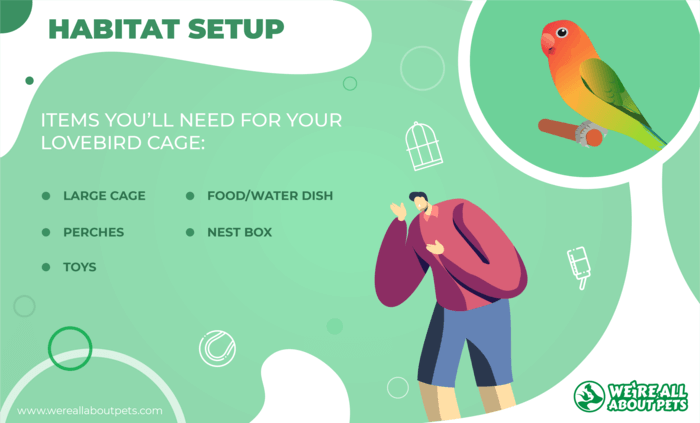
The lovebird may not be the largest pet bird around, but these little birds can be quite active. When it comes to choosing the best lovebird cage, the first thing you need to decide is whether you want to keep a single lovebird or a pair of lovebirds.
Lovebirds form strong bonds when given the opportunity. If you plan to keep a single lovebird, you’ll need to dedicate a great deal of time to interacting with your bird to keep it happy. A pair of lovebirds will keep each other company, but they may choose not to interact with people. It’s a tricky decision.
Here are some of the items you’ll need for your lovebird cage:
- Large Cage – A pair of lovebirds requires at least 35 cubic feet of space, cage size dimensions at minimum 24x18x24 inches. The larger the cage, the better.
- Perches – Provide at least two or three perches of different size and texture, placed at different heights in the cage. The smallest lovebird perch diameter recommended is ½ inch.
- Toys – Lovebirds are quite active birds so providing them with toys can help provide exercise and mental stimulation. Good ideas include swings, mirrors, bells, ropes, and balls.
- Food/Water Dish – Provide an appropriate number of food and water dishes for the number of birds you keep and make sure they aren’t placed directly below a perch. Clean all food and water containers daily.
- Nest Box – Your lovebirds need a nesting box in which to lay their eggs – it should be about 12 inches in diameter with a 3-inch hole.
Not only do you need to make sure your lovebird cage is properly outfitted, but you should also think about where you place it. Birds can be sensitive to drafts, so place the cage away from windows, doors, and air vents. It should be in a room where the birds can interact with you but not be overwhelmed.
Lovebird Diet
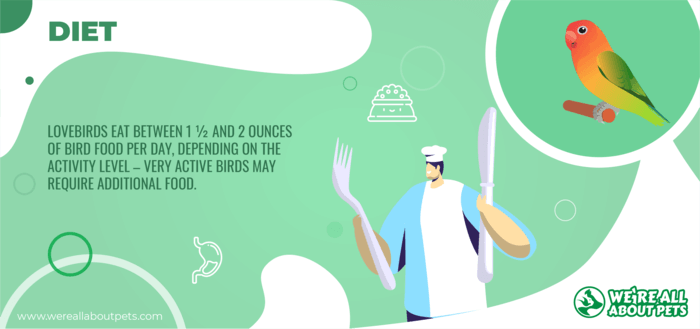
One of the most important aspects of pet care is providing your new pet with a healthy and balanced diet. Wild lovebirds feed primarily on seeds, grain, and berries as well as fresh fruit and fresh vegetables. Pet lovebirds can be fed seed mix or a formulated diet supplemented with fresh foods.
Here are some quick facts about the ideal lovebird diet:
- Lovebirds eat between 1 ½ and 2 ounces of bird food per day, depending on the activity level – very active birds may require additional food.
- Seeds or nutritionally balanced pellets should make up about 60% of your lovebird’s diet – even if you primarily feed seeds, add some pellets to provide essential nutrients.
- Supplement your lovebird’s diet with fresh foods up to 25% of the daily feeding – offer a variety of fresh fruits and veggies that are deemed safe for lovebirds to eat.
- Offer treats a few times a week in small amounts – good options include higher fat seeds like sunflower seed as well as millet spray, shelled nuts, hardboiled egg, and dried insects.
- Particularly for young birds, you may need to consider vitamin supplements. It is recommended you provide a cuttlebone for calcium as well.
In addition to food, be sure to provide your pet with unlimited access to fresh water as well. Fresh foods may provide some hydration, but you should keep water containers full as well.
Lovebird Veterinary Care
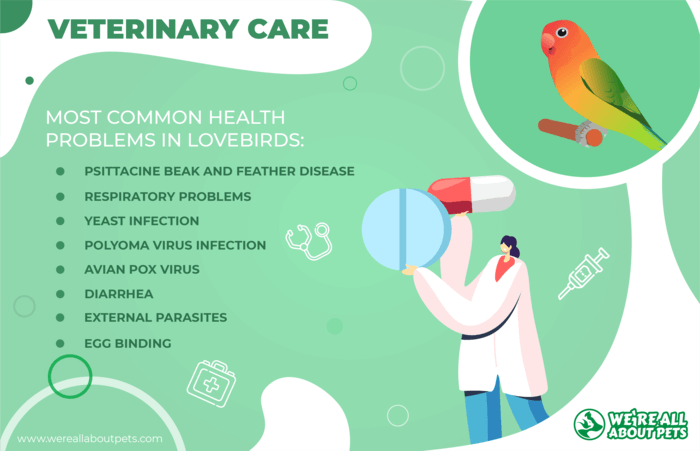
The best thing you can do to support your lovebird’s immune system and overall health is to meet his nutritional needs. Even if you take proper care of your pet bird, however, there will always be a risk of him getting sick. It’s a good idea to familiarize yourself with common health issues to be prepared.
Here are some of the most common health problems in lovebirds:
- Psittacine beak and feather disease
- Respiratory problems
- Yeast infection
- Polyoma virus infection
- Avian pox virus
- Diarrhea
- External parasites
- Egg binding
Within a few weeks of getting your new lovebirds, take them to an avian veterinarian. Not all vets care for birds, so you might need to do some research to find an avian or exotics vet in your area.
Lovebirds don’t require vaccinations, but it’s a good idea to have annual checkups. If your bird is prone to issues, you may want to make it more frequent at every six months. You should expect to pay between $35 and $50 per visit, not including any necessary tests or treatment.
Lovebird Fun Facts
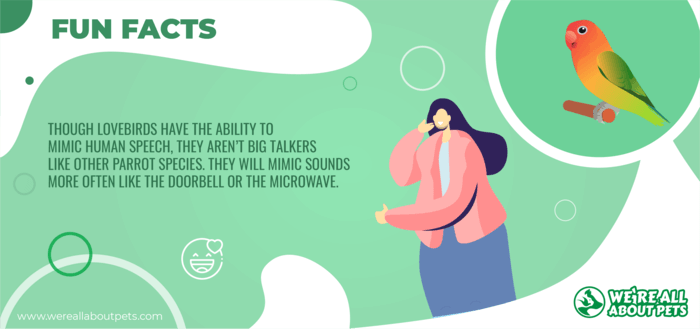
- Though lovebirds have the ability to mimic human speech, they aren’t big talkers like other parrot species. They will mimic sounds more often like the doorbell or the microwave.
- Lovebirds belong to the order Psittaciformes and they are a small genus of parrot. This puts them in the same category as other popular pet birds like the parakeet and cockatiel.
- The lovebird is named for its close pair bonds, but it goes beyond that – these birds reach sexual maturity around 10 months old and they mate for life. Monogamy is essential to the social stability of their flocks in the wild.
- If a lovebird’s mate dies, its companion exhibits behavior that is very similar to depression. When lovebird pets are kept alone, they may exhibit similar behavior.
- In their native habitats in Africa, lovebirds are cavity dwellers – they make their homes in holes found in shrubs, trees, and even rocks. In urban settings they can be found nesting in trees and cervices in buildings.
- Different lovebird species build their nests in different ways. Some carry single strips of bark in their beaks while others hide it in their feathers to be able to carry more at once.
- Surprisingly, aggression isn’t uncommon among lovebirds. They are territorial in the wild and have been known to get along poorly with other birds. They also become hormonal during mating season and can become jealous of other birds even in captivity.
Whether you’re a new bird owner or a seasoned bird enthusiast, the lovebird is a great pet to consider. The thing to keep in mind, however, is that all pets require a certain degree of time and commitment, so think carefully before you decide to add a new pet to your family.
Frequently Asked Questions
How long do lovebirds live?
The average lifespan for a pet lovebird is about 20 years, though it varies according to the quality of your pet’s diet and the amount of exercise and interaction he gets.
How much do lovebirds cost?
The cost to purchase a lovebird varies depending on the species you choose and whether you buy a single bird or a pair. There are nine species of lovebirds, but the most popular range from $50 to $200 in price. Expect to spend an additional $100 to $300 on your lovebird cage and up to $100 on other supplies. Monthly feeding costs are around $15 or so.
How big do lovebirds get?
Lovebirds are a small parrot, averaging 5 to 7 inches in height.
What do lovebirds eat?
In the wild, lovebirds feed on a variety of seeds, grains, and fruit as well as other vegetation. They may also consume insects as well, from time to time.
Are lovebirds good pets?
It depends what kind of pet you’re looking for. Lovebirds are not necessarily high maintenance, but they do require a significant amount of exercise. If you’re purchasing a single lovebird, be prepared to spend a lot of time interacting with your pet as well to meet his social needs.
Are lovebirds messy?
Parrots have a reputation for being messy and just because lovebirds are small doesn’t mean they are an exception. It’s important to use a liner in your bird cage to collect droppings and discarded bits of food. Daily spot cleaning will help keep things tidy and will reduce the amount of time you spend cleaning the entire cage at once.
Where do lovebirds come from?
Most lovebirds are native to Africa, except for the Madagascar lovebird which is native to the island of Madagascar. Lovebirds are small parrots belonging to the order Psittaciformes in the genus Agapornis.
Do lovebirds bite?
Biting is not a behavior common in lovebirds, but it can certainly happen if the bird feels frightened or overwhelmed. If your lovebird suddenly starts biting, take a closer look at the circumstances to see if you can identify a reason.
Do lovebirds sleep?
Lovebirds require between 10 and 12 hours of sleep per night. They typically sleep at night and are active during the day.
How long are lovebirds pregnant for?
Female lovebirds incubate their eggs for about 23 days with the average clutch size ranging from 3 to 5. Wild lovebirds typically lay eggs in February and July but pet lovebirds can mate any time of year.






